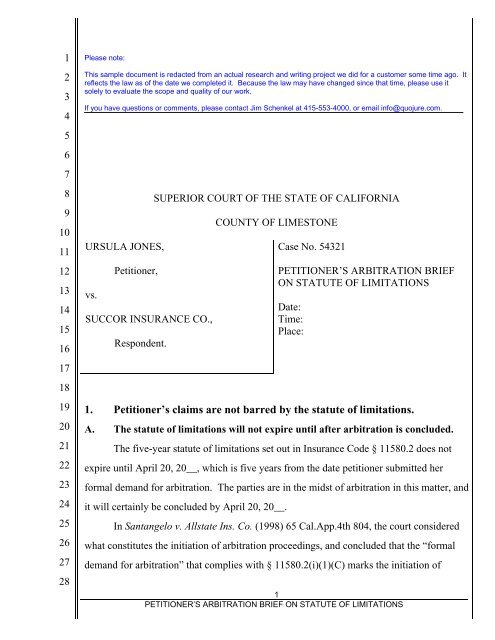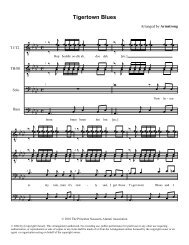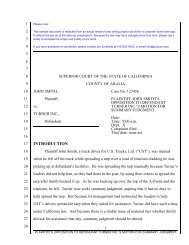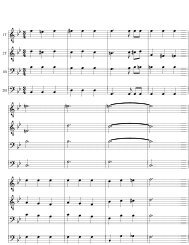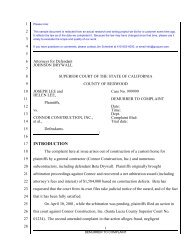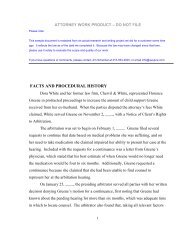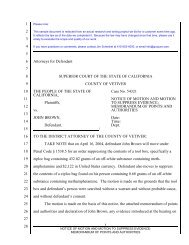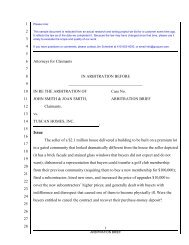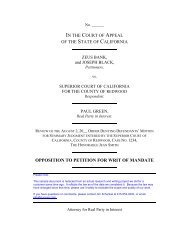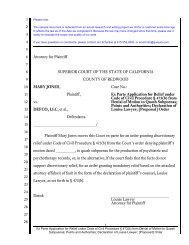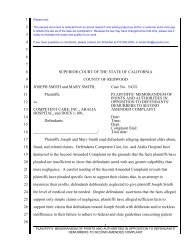1. Petitioner's claims are not barred by the statute of limitations.
1. Petitioner's claims are not barred by the statute of limitations.
1. Petitioner's claims are not barred by the statute of limitations.
Create successful ePaper yourself
Turn your PDF publications into a flip-book with our unique Google optimized e-Paper software.
1<br />
2<br />
3<br />
4<br />
5<br />
6<br />
7<br />
8<br />
9<br />
10<br />
11<br />
12<br />
13<br />
14<br />
15<br />
16<br />
17<br />
18<br />
19<br />
20<br />
21<br />
22<br />
23<br />
24<br />
25<br />
26<br />
27<br />
28<br />
Please <strong>not</strong>e:<br />
This sample document is redacted from an actual research and writing project we did for a customer some time ago. It<br />
reflects <strong>the</strong> law as <strong>of</strong> <strong>the</strong> date we completed it. Because <strong>the</strong> law may have changed since that time, please use it<br />
solely to evaluate <strong>the</strong> scope and quality <strong>of</strong> our work.<br />
If you have questions or comments, please contact Jim Schenkel at 415-553-4000, or email info@quojure.com.<br />
URSULA JONES,<br />
vs.<br />
Petitioner,<br />
SUCCOR INSURANCE CO.,<br />
Respondent.<br />
SUPERIOR COURT OF THE STATE OF CALIFORNIA<br />
COUNTY OF LIMESTONE<br />
Case No. 54321<br />
PETITIONER’S ARBITRATION BRIEF<br />
ON STATUTE OF LIMITATIONS<br />
Date:<br />
Time:<br />
Place:<br />
<strong>1.</strong> Petitioner’s <strong>claims</strong> <strong>are</strong> <strong>not</strong> <strong>barred</strong> <strong>by</strong> <strong>the</strong> <strong>statute</strong> <strong>of</strong> <strong>limitations</strong>.<br />
A. The <strong>statute</strong> <strong>of</strong> <strong>limitations</strong> will <strong>not</strong> expire until after arbitration is concluded.<br />
The five-year <strong>statute</strong> <strong>of</strong> <strong>limitations</strong> set out in Insurance Code § 11580.2 does <strong>not</strong><br />
expire until April 20, 20__, which is five years from <strong>the</strong> date petitioner submitted her<br />
formal demand for arbitration. The parties <strong>are</strong> in <strong>the</strong> midst <strong>of</strong> arbitration in this matter, and<br />
it will certainly be concluded <strong>by</strong> April 20, 20__.<br />
In Santangelo v. Allstate Ins. Co. (1998) 65 Cal.App.4th 804, <strong>the</strong> court considered<br />
what constitutes <strong>the</strong> initiation <strong>of</strong> arbitration proceedings, and concluded that <strong>the</strong> “formal<br />
demand for arbitration” that complies with § 11580.2(i)(1)(C) marks <strong>the</strong> initiation <strong>of</strong><br />
1<br />
PETITIONER’S ARBITRATION BRIEF ON STATUTE OF LIMITATIONS
1<br />
2<br />
3<br />
4<br />
5<br />
6<br />
7<br />
8<br />
9<br />
10<br />
11<br />
12<br />
13<br />
arbitration proceedings. Id. at 812.<br />
Here, <strong>the</strong> September 7, 20__ letter is <strong>not</strong> a formal demand for arbitration that<br />
complies with <strong>the</strong> requirements <strong>of</strong> § 11580.2. In fact, this letter does <strong>not</strong> even mention <strong>the</strong><br />
word “arbitration”; it is merely former counsel’s status letter, updating respondent<br />
regarding <strong>the</strong> settlement with <strong>the</strong> underlying defendant, and informing respondent that a<br />
demand package would be forwarded. Likewise, <strong>the</strong> January 30, 20__ letter does <strong>not</strong><br />
constitute a formal demand for arbitration under <strong>the</strong> code. Again, <strong>the</strong>re is no mention <strong>of</strong><br />
arbitration or a demand that <strong>the</strong> matter be referred to arbitration. This letter is simply a<br />
<strong>not</strong>ification <strong>of</strong> representation from petitioner’s new counsel and a request to open a file.<br />
The only piece <strong>of</strong> correspondence between petitioner and respondent that even mentions<br />
arbitration is <strong>the</strong> April 20, 20__ “Demand for Arbitration.” Hence, this is <strong>the</strong> only letter<br />
that can reasonably be interpreted as a formal demand for arbitration, starting <strong>the</strong> running<br />
<strong>of</strong> <strong>the</strong> five-year <strong>statute</strong> <strong>of</strong> <strong>limitations</strong>.<br />
14<br />
15<br />
16<br />
17<br />
18<br />
19<br />
20<br />
21<br />
22<br />
23<br />
B. Defendants <strong>are</strong> estopped from raising <strong>the</strong> <strong>statute</strong> <strong>of</strong> <strong>limitations</strong> at this late date.<br />
The Petition to Compel Arbitration was filed on January 13, 20__. Respondent did<br />
<strong>not</strong> oppose it, and particularly did <strong>not</strong> raise <strong>the</strong> issue <strong>of</strong> <strong>the</strong> <strong>statute</strong> <strong>of</strong> <strong>limitations</strong> in its<br />
response. Respondent is estopped from doing so now because, in <strong>the</strong> interim, petitioner<br />
has expended considerable time and expense preparing for a full-blown arbitration. See<br />
Berman v. Health Net (2000) 80 Cal.App.4th 1359 (discussing prejudice resulting from<br />
delay in compelling arbitration). Thus respondent should be estopped from asserting <strong>the</strong><br />
<strong>statute</strong> <strong>of</strong> <strong>limitations</strong> at this late date, since it has seemingly voluntarily acquiesced to<br />
arbitration and petitioner was <strong>the</strong>re<strong>by</strong> prejudiced <strong>by</strong> fully preparing for it on <strong>the</strong> merits.<br />
24<br />
25<br />
26<br />
27<br />
28<br />
C. The <strong>statute</strong> <strong>of</strong> <strong>limitations</strong> is <strong>not</strong> arbitrable.<br />
Statutes <strong>of</strong> <strong>limitations</strong> <strong>are</strong> generally <strong>not</strong> arbitrable in uninsured and underinsured<br />
motorists cases. Freeman v. State Farm Mut. Auto. Ins. Co. (1975) 14 Cal.3d 473. The<br />
Freeman court held that <strong>the</strong> language <strong>of</strong> Insurance Code § 11580.2(f) requires arbitration<br />
2<br />
PETITIONER’S ARBITRATION BRIEF ON STATUTE OF LIMITATIONS
1<br />
2<br />
3<br />
4<br />
5<br />
<strong>of</strong> only two issues: (1) whe<strong>the</strong>r <strong>the</strong> insured is entitled to recover against <strong>the</strong> uninsured<br />
motorist; and (2) if so, <strong>the</strong> amount <strong>of</strong> recoverable damages. Id. at 48<strong>1.</strong> Thus <strong>the</strong> <strong>statute</strong> <strong>of</strong><br />
<strong>limitations</strong> issue was for judicial determination before <strong>the</strong> arbitration. This issue could<br />
have—and should have—been raised in opposition to <strong>the</strong> petition to compel arbitration,<br />
but respondent elected <strong>not</strong> to pursue this <strong>the</strong>ory in <strong>the</strong> proper forum at <strong>the</strong> appropriate time.<br />
6<br />
7<br />
8<br />
9<br />
10<br />
11<br />
12<br />
D. Respondent asserted <strong>the</strong> <strong>statute</strong> <strong>of</strong> <strong>limitations</strong> argument in bad faith.<br />
Considering that respondent’s <strong>statute</strong> <strong>of</strong> <strong>limitations</strong> argument is wrong on <strong>the</strong> law<br />
and <strong>the</strong> facts, and was raised at <strong>the</strong> last possible minute and in <strong>the</strong> wrong forum, <strong>the</strong>re<br />
should be little question that it was <strong>not</strong> raised in good faith under Insurance Code<br />
§ 11580.26. Thus it breaches <strong>the</strong> covenant <strong>of</strong> good faith and fair dealing respondent owes<br />
to its insured.<br />
13<br />
14<br />
15<br />
16<br />
17<br />
18<br />
19<br />
20<br />
21<br />
22<br />
23<br />
24<br />
2. Defendant admitted <strong>the</strong>re was no evidence <strong>of</strong> contributory negligence.<br />
Code <strong>of</strong> Civil Procedure § 2030.410 provides that responses to interrogatories may<br />
be used at trial against <strong>the</strong> responding party. Admissions contained in interrogatories <strong>are</strong><br />
admissible in evidence to establish any material fact. Leasman v. Beech Aircraft Corp.<br />
(1975) 48 Cal.App.3d 376, 380. Here, defendant responded to form interrogatories 20.9<br />
and 20.10 <strong>by</strong> stating that she had no information regarding any defect in petitioner’s<br />
vehicle that contributed to <strong>the</strong> accident. But when petitioner was deposed some eight years<br />
after <strong>the</strong> accident, and well after defendant served <strong>the</strong>se responses, respondent seemed to<br />
be attempting to establish a contributory negligence defense concerning <strong>the</strong> condition <strong>of</strong><br />
petitioner’s vehicle. The admissions contained in defendant’s discovery responses<br />
preclude such an argument.<br />
25<br />
26<br />
27<br />
28<br />
3. The accident was a substantial factor in causing petitioner’s injuries.<br />
California Jury Instruction 430 states that a substantial factor in causing harm is a<br />
factor that a reasonable person would consider to have contributed to <strong>the</strong> harm. It does <strong>not</strong><br />
3<br />
PETITIONER’S ARBITRATION BRIEF ON STATUTE OF LIMITATIONS
1<br />
2<br />
3<br />
4<br />
5<br />
6<br />
7<br />
8<br />
9<br />
10<br />
11<br />
12<br />
13<br />
14<br />
15<br />
16<br />
17<br />
18<br />
19<br />
20<br />
have to be <strong>the</strong> only cause <strong>of</strong> <strong>the</strong> harm, but it does have to be more than a remote or trivial<br />
factor. Instruction 430 fur<strong>the</strong>r states that conduct is <strong>not</strong> a substantial factor in causing<br />
harm if <strong>the</strong> same harm would have occurred without <strong>the</strong> conduct. In a personal injury<br />
action, causation must be proved within a reasonable medical probability based on<br />
competent expert testimony. Espinosa v. Little Co. <strong>of</strong> Mary Hosp. (1995) 31 Cal.App.4th<br />
1304, 1316. A possible cause only becomes a probable cause when, in <strong>the</strong> absence <strong>of</strong><br />
o<strong>the</strong>r reasonable causal explanations, it becomes more likely than <strong>not</strong> that <strong>the</strong> injury was<br />
<strong>the</strong> result <strong>of</strong> that action. Ibid.<br />
Here, respondent’s expert admitted that <strong>the</strong> accident caused petitioner’s<br />
asymptomatic back problems to become symptomatic, but drew <strong>the</strong> legal conclusion that it<br />
was only a “minor” cause. Having conceded that <strong>the</strong> accident was a factor in causing<br />
petitioner’s injuries, he <strong>the</strong>n testified that he could <strong>not</strong> cite to any o<strong>the</strong>r reasonable cause<br />
for petitioner’s current disability from her back condition. And, although he opined that<br />
petitioner’s symptoms would have subsided in three months had she <strong>not</strong> had a pre-existing<br />
condition, <strong>the</strong> expert also testified that he could <strong>not</strong> say with any degree <strong>of</strong> medical<br />
certainty that petitioner would have been disabled from her pre-existing condition had this<br />
accident <strong>not</strong> happened. The expert’s testimony here demonstrates that this accident must<br />
be deemed a substantial factor in causing petitioner’s current condition—since <strong>the</strong>re is an<br />
absence <strong>of</strong> o<strong>the</strong>r reasonable causal explanations, this possible cause becomes a probable<br />
cause, and it becomes more likely than <strong>not</strong> that <strong>the</strong> accident caused petitioner’s condition.<br />
21<br />
22<br />
23<br />
24<br />
25<br />
26<br />
27<br />
28<br />
4. Certain evidence here should be viewed with distrust.<br />
Evidence Code § 412 provides that, if weaker and less satisfactory evidence is<br />
<strong>of</strong>fered when it was within <strong>the</strong> party’s power to produce stronger and more satisfactory<br />
evidence, <strong>the</strong> evidence <strong>of</strong>fered should be viewed with distrust. Likewise, California Civil<br />
Jury Instruction 203 provides that <strong>the</strong> jury may consider <strong>the</strong> ability <strong>of</strong> each party to provide<br />
evidence, and if a party provides weaker evidence when it could have provided stronger<br />
evidence, <strong>the</strong> jury may distrust <strong>the</strong> weaker evidence.<br />
4<br />
PETITIONER’S ARBITRATION BRIEF ON STATUTE OF LIMITATIONS
1<br />
2<br />
3<br />
4<br />
5<br />
6<br />
7<br />
8<br />
9<br />
10<br />
11<br />
12<br />
13<br />
14<br />
15<br />
16<br />
17<br />
18<br />
19<br />
20<br />
21<br />
22<br />
23<br />
24<br />
25<br />
26<br />
27<br />
28<br />
Here, <strong>the</strong> underlying defendant never revealed <strong>the</strong> identity <strong>of</strong> two additional<br />
witnesses to <strong>the</strong> accident. Two passengers traveling in defendant’s vehicle at <strong>the</strong> time <strong>of</strong><br />
<strong>the</strong> accident fled <strong>the</strong> scene. Defendant refused to identify <strong>the</strong> individuals who were in his<br />
car, and in response to discovery requests simply said that <strong>the</strong>ir names remained unknown,<br />
but that investigation was continuing. Thus defendant, and now respondent, was in a<br />
position to produce stronger evidence as to how <strong>the</strong> accident occurred, through <strong>the</strong><br />
testimony <strong>of</strong> two additional percipient witnesses who <strong>are</strong>, arguably, independent witnesses.<br />
But defendant did <strong>not</strong> do so. Since it was within defendant’s and respondent’s power to<br />
produce this evidence, <strong>the</strong> evidence that was <strong>of</strong>fered instead <strong>of</strong> it should be viewed with<br />
distrust.<br />
Dated:<br />
___________________________________<br />
Attorneys for Petitioner<br />
5<br />
PETITIONER’S ARBITRATION BRIEF ON STATUTE OF LIMITATIONS


